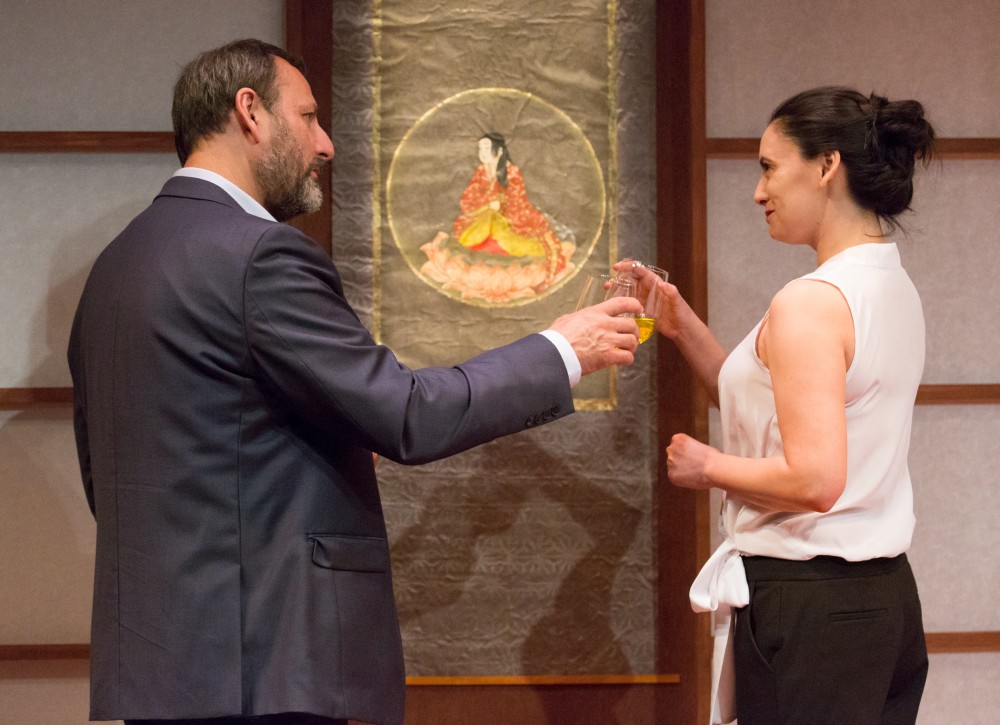(A disclaimer in fine print) “The vendor will not be responsible for the correctness of description, authenticity, or any defect or fault in or concerning any article, and makes no warranty whatever, but will sell each object exactly as is, without recourse.”—Naomi Iizuka, 36 VIEWS

“Beauty is beauty”, says Darius Wheeler (Joe Guzmán), an unscrupulous art dealer in Naomi Iizuka’s 36 VIEWS; and later: “Happy is happy”. But things aren’t so simple in Iizuka’s play, now in a kabuki-inflected production by Lantern Theater Company.
Lantern took some criticism a couple seasons ago for a production of Julius Caesar carelessly dressed with Japanese (and—damningly—other Asian) aesthetics. 36 VIEWS brings a welcome tonic.
Jorge Cousineau’s set and sound design retains the slatted screens of the Julius Caesar production, but he uses them to creatively complement Peter DeLaurier’s direction. The screens slide apart for entrances or to reveal hidden artworks, become canvases onto which are projected stage-encompassing Hokusai Mt. Fuji prints, or transform into writing scrolls for Japanese calligraphy.
As the play opens, the screens part to create a doorway and separate to show a shelf of pottery and an illuminated painting. Wheeler is trying to impress Setsuko Hearn (Joanna Liao), an academic interested in 11th-century pillow books (personal literary works by courtly Japanese women).
Wheeler’s straight-laced assistant John Bell (David Pica, in a subtle and skilled supporting role) passes his own poetry off as a millennium-old example of this genre in an inventive fit of embarrassment. The dealer seizes the opportunity to charm a delighted Hearn; her boss, stuffily outdated professor Owen Mattheisen (Stephen Novelli) is eager to accept the unseen document’s veracity.
As this summary indicates, 36 VIEWS is neatly plotted. Subplots involving a mysterious art purchaser (Angela Smith) and a disgruntled conservator Claire (Bi Jean Ngo) come together; loose ends tied as neatly as a Law and Order episode. Some plot points stretch belief: would an academic really call a press conference about an unseen manuscript? Would the press care?
Likewise, Iizuka’s dialog attempts a contemporary breeziness (“What are you?” “I don’t know Claire, that’s very existential.”) that sometimes oversteps into stilted affectation (“You’re very pleased with yourself, aren’t you?” “Actually, I’m wracked with self-doubt.”) Guzman, in particular, plays Wheeler (“a philosopher and also quite the renegade”) with an exaggerated smarminess that plays up the over-cleverness of the script.
“All kabuki elements in this production exist in Ms. Iizuka’s script,” we’re told in the program, as if to preclude expected criticism for the misuse of this traditional Japanese theater. These elements—wooden clappers underscoring emotional moments, costumed assistants (Paul Deichman and uncredited) aiding with scene changes, stylized movement—add to the self-conscious theatricality of Iizuka’s play. Yes, she seems to be saying, this is drama: the plot is neat, the dialog is stagey.
But Iizuka uses the conventions of contemporary and traditional theater to challenge her audience. Just as that priceless artwork may not be what it seems, many characters in 36 VIEWS hide self-truths; the well-constructed plot twists alter our perceptions of these characters. The staid assistant is a flowery poet, the mysterious woman is not what she seems. The very framework of the narrative is malleable.
(Wooden clappers sound.) “Always read the fine print. There is always fine print,” says Claire.

The title 36 VIEWS refers to a series of works by Japanese master Katsushika Hokusai of Mt. Fuji. Hokusai rendered the towering mountain dozens of times from different angles (you’re familiar with the one of the wave, at least), changing the way we view it in each. So Iizuka presents shifting perspectives on her characters. Are they even “real”? What does that mean in the artifice of theater and art?
In dialog and action, Iizuka comments on these ideas. Satisfyingly, she never provides an answer, and perhaps in doing so provides an answer. Visually beautiful and compelling in its coherence, the Lantern’s production of 36 VIEWS works its magic subtly and weaves these intellectual concepts on the uncertainty of art and life with a wholly original style.
Or, at least, that’s one view.
[St. Stephens Theatre, 10th and Ludlow streets] May 26-June 26, 2016; lanterntheater.org.
